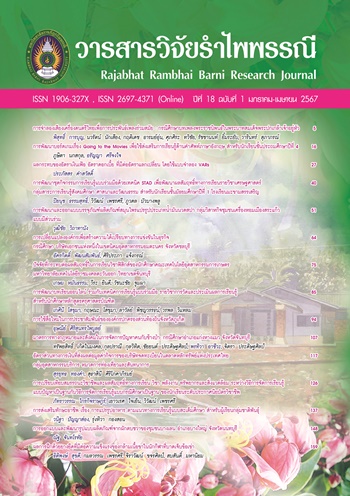การออกแบบและพัฒนารูปแบบผลิตภัณฑ์จากผักตบชวาของชุมชนบางเลน อำเภอบางใหญ่ จังหวัดนนทบุรี
Main Article Content
บทคัดย่อ
การวิจัยนี้มีวัตถุประสงค์ 1) ศึกษารูปแบบผลิตภัณฑ์จากผักตบชวา ที่เหมาะสมกับศักยภาพการทำงานของกลุ่มชุมชน 2) การออกแบบผลิตภัณฑ์ต้นแบบ และ 3) ผลประเมินความคิดเห็นต่อผลิตภัณฑ์ต้นแบบ ใช้วิธีวิจัยเชิงปฏิบัติการแบบมีส่วนร่วม (PAR) โดยแบ่งออกเป็นระบบย่อย ๆ 4 ระบบ คือ ระบบวางแผน ระบบปฏิบัติการ ระบบติดตามตรวจสอบ และ ระบบสะท้อนผล มาเป็นโครงสร้างของระบบประยุกต์ใช้ร่วมกับการวิจัยและพัฒนา (R&D) ดำเนินการวิจัย 3 รอบ คือ R1D1, R2D2 และ R3D3 พื้นที่วิจัย คือชุมชนบางเลน อำเภอบางใหญ่ จังหวัดนนทบุรี ใช้การจัดสนทนากลุ่ม กลุ่มข้อมูลสำคัญ มี 4 กลุ่ม ได้แก่ กลุ่มชุมชน ตัวแทนเจ้าหน้าที่รัฐ และผู้เชี่ยวชาญด้านการออกแบบ ใช้วิธีคัดเลือกแบบเจาะจง และกลุ่มลูกค้าที่สนใจผลิตภัณฑ์จากธรรมชาติ โดยวิธีการสุ่มอย่างง่าย เครื่องมือที่ใช้ในการวิจัย คือ แบบสัมภาษณ์ แบบประเมินการออกแบบ แบบสอบถามความคิดเห็น วิเคราะห์ข้อมูลโดยใช้การวิเคราะห์เนื้อหา และ ใช้ค่าร้อยละ ค่าเฉลี่ย และค่าส่วนเบี่ยงเบนมาตรฐาน ผลการวิจัยพบว่า 1) รูปแบบผลิตภัณฑ์ที่เหมาะสมกับเงื่อนไขของกลุ่มชุมชนประดิษฐ์เป็นดอกไม้จากกระดาษผักตบชวา 2) ชุมชนผลิตกระดาษจากผักตบชวาจากนั้นนำมาสร้างต้นแบบเบื้องต้นโดยทำเป็นดอกไม้ประดิษฐ์และนำมาพัฒนาประยุกต์ตกแต่งเป็นพานพุ่ม และพวงหรีดดอกไม้กระดาษ 3) ผลประเมินในภาพรวม พบว่าอยู่ในระดับดี มีค่าเฉลี่ย 3.97 (S.D.=0.55) คุณค่าในงานหัตถกรรมชุมชน ในระดับดีมากที่สุด มีค่าเฉลี่ย 5.00 (S.D.=0.00) รองลงมาคือ ความเหมาะสมกับประโยชน์ใช้สอยในระดับดีมากที่สุด มีค่าเฉลี่ย 4.67 (S.D.=0.58) และด้านความสวยงามของผลิตภัณฑ์ มีค่าเฉลี่ย 4.33 (S.D.=0.58) ตามลำดับ ข้อค้นพบจากงานวิจัยนี้ คือ การแสวงหาความคิดใหม่เกี่ยวกับรูปแบบผลิตภัณฑ์จากผักตบชวาจะสามารถหาแนวคิดได้จากทักษะความรู้เดิมของชุมชน มาเพิ่มเติมต่อยอดความรู้ให้เกิดผลิตภัณฑ์ขึ้นใหม่ในลักษณะการใช้วัตถุดิบอื่นมาทดแทน (Substitute)
Article Details

อนุญาตภายใต้เงื่อนไข Creative Commons Attribution-NonCommercial-NoDerivatives 4.0 International License.
เอกสารอ้างอิง
ทรัพย์ อมรภิญโญ. (2564). การยกระดับผลิตภัณฑ์เชิงสร้างสรรค์โดยกระบวนการวิจัยเชิงปฏิบัติการแบบมีส่วนร่วม วิสาหกิจชุมชนกลุ่มแม่บ้านเกษตรกรบ้านกองนาง อำเภอท่าบ่อ จังหวัดหนองคาย. วารสารวิทยาการจัดการ มหาวิทยาลัยราชภัฏอุดรธานี. 3 (พฤศจิกายน-ธันวาคม): 104-121.
ธีรวุฒิ เอกะกุล. (2551). การวิจัยปฏิบัติการ. อุบลราชธานี: บริษัทยงสวัสดิ์อินเตอร์กรุ๊ป จำกัด.
บุษรา บรรจงการ และยุทธนา พรรคอนันต์. (2565). การศึกษาแนวคิดต่อผลิตภัณฑ์จากเปลือกทุเรียนและการวิจัยตลาดของผลิตภัณฑ์ใหม่จากเปลือกทุเรียน. วารสารวิจัยรำไพพรรณี. 16 (1): 66-78.
พจนารถ บัวเขียว. (2554). แนวทางการพัฒนาผลิตภัณฑ์ชุมชน. [Online]. เข้าถึงได้จาก : http://research.pbru.ac.th/web/attachments/244_product_community.pdf. 2564.
พรพิมล ศักดา และบวร เครือรัตน์. (2561). การพัฒนาผลิตภัณฑ์ชุมชนประเภทของใช้จากวัสดุธรรมชาติของกลุ่มอาชีพเสริมบ้านสุขเกษม ตำบลบางเลน อำเภอบางเลน จังหวัดนครปฐม. รายงานการวิจัย มหาวิทยาลัยเทคโนโลยีราชมงคลรัตนโกสินทร์.
พัชรี ศรีสังข์. (2555). การวิจัยและพัฒนาในงานพัฒนาชุมชน. วารสารสังคมศาสตร์ มหาวิทยาลัยศรีนครินทรวิโรฒ. 15(มกราคม-ธันวาคม): 137-143.
เมธาวี จำเนียร. (2564). อัตลักษณ์ผลิตภัณฑ์ชุมชนสู่การสร้างและสื่อสารแบรนด์ กรณีศึกษา การแสดงรำโทนนกพิทิด. วารสารราชพฤกษ์. 11 (พฤษภาคม-สิงหาคม): 1-12.
สถานีโทรทัศน์ไทยพีบีเอส. (2563). ผักตบชวาแน่นเต็มคลองบางใหญ่ จ.นนทบุรี ปชช. สัญจรไม่ได้. [Online]. เข้าถึงได้จาก : https://news.thaipbs.or.th/content/288032. 2564.
สำนักงานการวิจัยแห่งชาติ. (2562). การใช้ประโยชน์จากผักตบชวา ภายใต้โครงการจิตอาสาพัฒนาสิ่งแวดล้อมและคุณภาพชีวิตของประชาชนเฉลิมพระเกียรติเนื่องในโอกาสมหามงคลพระราชพิธีบรมราชาภิเษก. กรุงเทพมหานคร: กระทรวงอุดมศึกษา วิทยาศาสตร์ วิจัยและนวัตกรรม.
สิทธิณัฐ ประพุทธนิติศาสตร์. (2547). การวิจัยเชิงปฏิบัติการแบบมีส่วนร่วม : แนวคิด และแนวปฏิบัติ. พิมพ์ครั้งที่ 3. กรุงเทพมหานคร: สำนักงานกองทุนสนับสนุนการวิจัย (สกว.).
สุกัญญา อธิปอนันต์. (2542). การวิจัยเชิงปฏิบัติการแบบมีส่วนร่วมในงานส่งเสริมการเกษตร โดยกระบวนการ A-I-C. กรุงเทพมหานคร: กองแผนงาน กรมส่งเสริมการเกษตร.
สุดาดวง เรืองรุจิระ. (2538). นโยบายผลิตภัณฑ์และราคา. กรุงเทพมหานคร : สำนักพิมพ์ประกายพรึก.
สุธีรา ชูบัณฑิต. (2557). ผักตบชวา…ปัญหาระดับชาติ: กฎหมายกำจัดผักตบชวา. กรุงเทพมหานคร: สำนักงานเลขาธิการวุฒิสภา.


